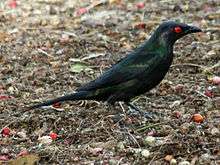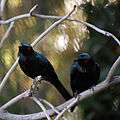Metallic starling
| Metallic starling | |
|---|---|
 | |
| At Cairns, Australia | |
| Scientific classification | |
| Kingdom: | Animalia |
| Phylum: | Chordata |
| Class: | Aves |
| Order: | Passeriformes |
| Family: | Sturnidae |
| Genus: | Aplonis |
| Species: | A. metallica |
| Binomial name | |
| Aplonis metallica (Temminck, 1824) | |
The metallic starling (Aplonis metallica), also known as shining starling, is a bird in the starling family. It is native of Papua New Guinea and nearby Australasian islands, and a limited area of northeastern Australia.
Description


The adult has brilliant red eyes, a long forked tail and green-glossed black plumage. Immatures are pale below with dark streaks.
Behaviour
They are very social and flocks of them build messy suspended globular nests in tall rain forest trees where they breed, possibly only during the wet season (north-west monsoon, October–March) (observed at Kokopo, East New Britain Province, 2016). They are not fearful of humans and their activity on the ground below, being well separated from them by altitude, but a loud noise will see them fly out in a tight formation, circle, then return to their nests. Their movement is very fast. During the early part of the 20th century, a flock (or flocks) were seen to migrate during August[2] to Dunk Island in far north Queensland, where they mate, preparing messy globular nests for their young which hang from tall trees.[3] There they remain until April,[2] whereupon they make their return journey to ??? (destination unknown).
Gallery

- Juveniles, Cairns Esplanade, N Qld
 Female with nest - Cairns
Female with nest - Cairns
 Feeding on Ptychosperma elegans fruit in Cairns
Feeding on Ptychosperma elegans fruit in Cairns Metallic Starlings around high nests in the Daintree Rainforest in QLD.
Metallic Starlings around high nests in the Daintree Rainforest in QLD.
References
- ↑ BirdLife International (2012). "Aplonis metallica". IUCN Red List of Threatened Species. Version 2013.2. International Union for Conservation of Nature. Retrieved 26 November 2013.
- 1 2 Banfield, E.J. "Alike in Difference." Emu. Vol. 17, No. 4, 212-214. 1917. Accessed 2009-05-25.
- ↑ "Plants and Animals in the Wet tropics." Wet Tropics Management Authority. Accessed 2009-05-25.
